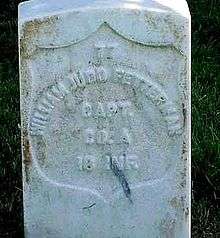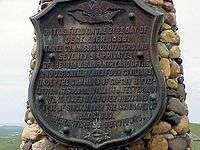William J. Fetterman
| William Judd Fetterman | |
|---|---|
 William J. Fetterman's Headstone, Little Bighorn National Cemetery | |
| Born |
1833? New London, Connecticut (disputed) |
| Died |
December 21, 1866 (aged 33) Near Fort Phil Kearny, Wyoming |
| Buried at | National Cemetery, Little Bighorn Battlefield National Monument |
| Allegiance |
Union |
| Service/branch |
Union Army |
| Years of service | 1861 - 1866 |
| Rank |
|
| Unit | 18th Infantry Regiment |
| Wars | |
William Judd Fetterman (1833 – December 21, 1866) was an officer in the United States Army during the American Civil War and the subsequent Red Cloud's War on the Great Plains. Fetterman and his command of 80 men were killed in the Fetterman Fight.
Early life
Fetterman was probably born in New London, Connecticut, although this is uncertain. His father was a career Army officer of Pennsylvania Dutch (German) descent.
Military career
Fetterman enlisted in the Union Army on May 14, 1861, in Delaware, and was promptly commissioned a first lieutenant. He served with the First Battalion of the US 18th Infantry Regiment throughout the war and was twice brevetted for gallant conduct, finishing the war as a lieutenant colonel of Volunteers.
After the war, he chose to remain in the Regular Army and was assigned as a captain in the Second Battalion of the 18th Infantry Regiment. In November 1866, the regiment was stationed at Fort Phil Kearny, tasked with protecting immigrants traveling to the gold fields of Montana Territory along the Bozeman Trail. Fetterman allegedly boasted that with 80 soldiers, he could "ride through the Sioux Nation".
On December 21, 1866, a large band of Cheyenne and Sioux – which included Crazy Horse – under the leadership of Red Cloud attacked a wood train near the fort. Despite his unfamiliarity with frontier conditions and the methods of Indian fighting, Fetterman took command of a composite reaction force consisting of the former battalion quartermaster, Captain Frederick Brown, 2nd Lt. George Grummond, 49 enlisted troops of the 18th Infantry, 27 men of the 2nd Cavalry, and 2 civilian scouts, ironically totaling 80 men. Ignoring his orders not to venture beyond Lodge Trail Ridge (out of sight and support distance from the fort), Fetterman pursued a small band of Sioux and was lured into an ambush. He found himself facing approximately 2,000 Indians. Within 20 minutes, Fetterman and his command had been wiped out.

The Fetterman Massacre, as the encounter became known, was second in notoriety only to Custer's disastrous defeat in 1876. It led to the dismissal of Fetterman's commanding officer, Henry B. Carrington, who was initially blamed for the disaster, but was eventually exonerated.
Fetterman's grave is in the National Cemetery at the Little Bighorn Battlefield National Monument. He had never married and left no heirs. His pension was sent to his mother.
Legacy
In 1867, the army designated a new outpost in the Dakota Territory as "Fort Fetterman" in honor of the slain officer.[1] There is also a Fetterman Street and Fetterman Drive in Laramie, Wyoming.
The actor Robert Fuller played the role of Fetterman in the episode, "Massacre at Fort Phil Kearny", which aired on October 26, 1966, on NBC's anthology television series, Bob Hope Presents the Chrysler Theatre. Others who appeared in the segment were Richard Egan and Phyllis Avery as Colonel Henry Carrington and his wife, Margaret Carrington, Robert Pine as Lieutenant Brown, and Carroll O'Connor as Captain Ten Eyck.[2]
Notes
- ↑ Gannett, Henry (1905). The Origin of Certain Place Names in the United States. Govt. Print. Off. p. 129.
- ↑ "Bob Hope Presents the Chrysler Theatre: Massacre at Fort Phil Kearney". Internet Movie Data Base. Retrieved January 30, 2010.
References
- Brown, Dee, The Fetterman Massacre, University of Nebraska Press, 1971. ISBN 0-8032-5730-9.